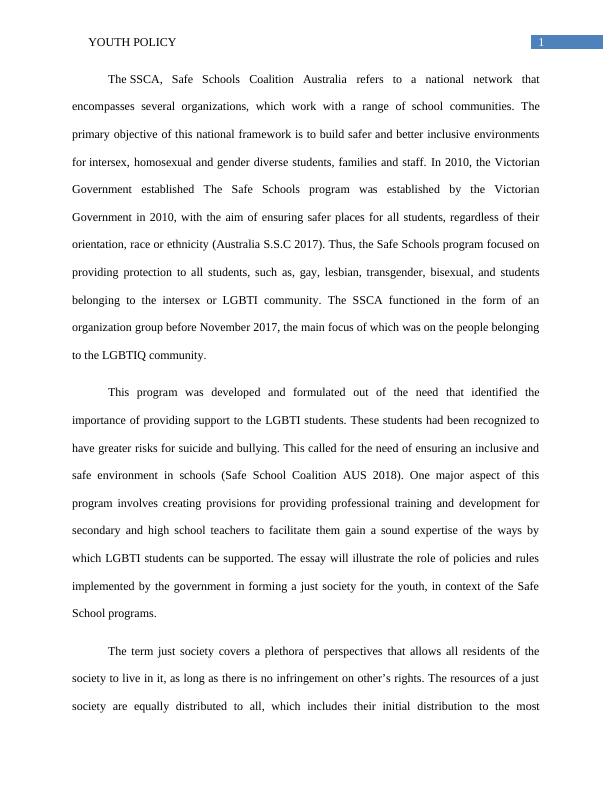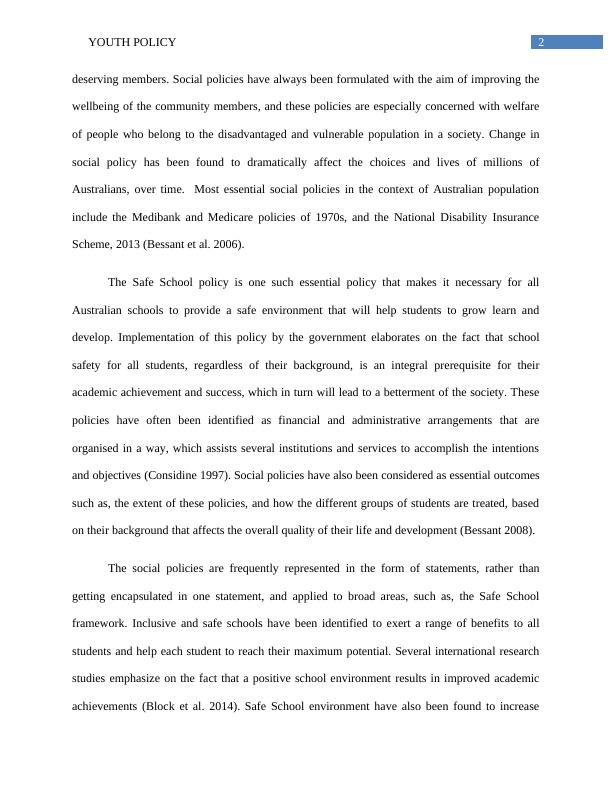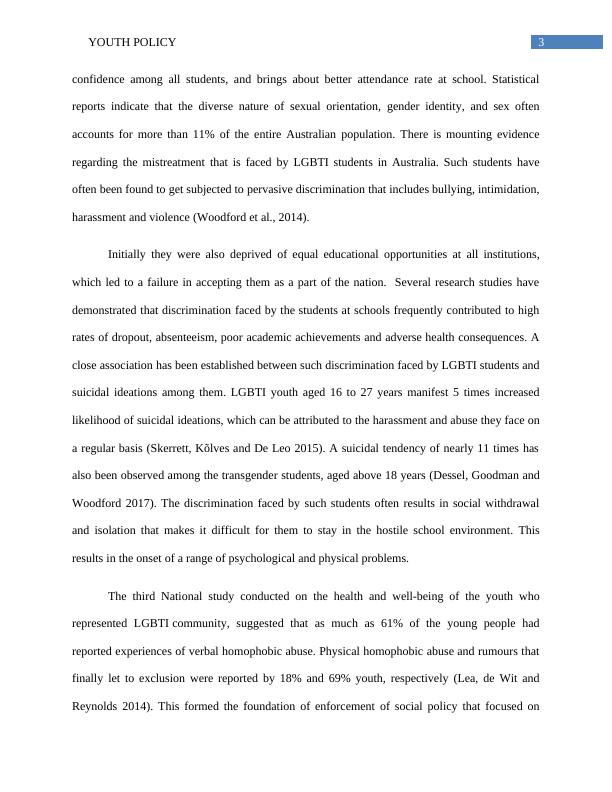Ask a question from expert
(PDF) Introduction to Youth Policies
12 Pages3343 Words83 Views
Added on 2021-05-30
(PDF) Introduction to Youth Policies
Added on 2021-05-30
BookmarkShareRelated Documents
Running head: YOUTH POLICYGovernment policies and Safe SchoolsName of the StudentName of the UniversityAuthor Note

1YOUTH POLICYTheSSCA, Safe Schools Coalition Australia refers to a national network thatencompasses several organizations, which work with a range of school communities. Theprimary objective of this national framework is to build safer and better inclusive environmentsforintersex, homosexual and gender diverse students, families and staff. In 2010, the VictorianGovernment established The Safe Schools program was established by the VictorianGovernment in 2010, with the aim of ensuring safer places for all students, regardless of theirorientation, race or ethnicity (Australia S.S.C 2017). Thus, the Safe Schools program focused onproviding protection to all students, such as, gay, lesbian, transgender, bisexual, and studentsbelonging to the intersex or LGBTI community. The SSCA functioned in the form of anorganization group before November 2017, the main focus of which was on the people belongingto the LGBTIQ community. This program was developed and formulated out of the need that identified theimportance of providing support to the LGBTI students. These students had been recognized tohave greater risks for suicide and bullying. This called for the need of ensuring an inclusive andsafe environment in schools (Safe School Coalition AUS 2018). One major aspect of thisprogram involves creating provisions for providing professional training and development forsecondary and high school teachers to facilitate them gain a sound expertise of the ways bywhich LGBTI students can be supported. The essay will illustrate the role of policies and rulesimplemented by the government in forming a just society for the youth, in context of the SafeSchool programs.The term just society covers a plethora of perspectives that allows all residents of thesociety to live in it, as long as there is no infringement on other’s rights. The resources of a justsociety are equally distributed to all, which includes their initial distribution to the most

2YOUTH POLICYdeserving members. Social policies have always been formulated with the aim of improving thewellbeing of the community members, and these policies are especially concerned with welfareof people who belong to the disadvantaged and vulnerable population in a society. Change insocial policy has been found to dramatically affect the choices and lives of millions ofAustralians, over time. Most essential social policies in the context of Australian populationinclude the Medibank and Medicare policies of 1970s, and the National Disability InsuranceScheme, 2013 (Bessant et al. 2006). The Safe School policy is one such essential policy that makes it necessary for allAustralian schools to provide a safe environment that will help students to grow learn anddevelop. Implementation of this policy by the government elaborates on the fact that schoolsafety for all students, regardless of their background, is an integral prerequisite for theiracademic achievement and success, which in turn will lead to a betterment of the society. Thesepolicies have often been identified as financial and administrative arrangements that areorganised in a way, which assists several institutions and services to accomplish the intentionsand objectives (Considine 1997). Social policies have also been considered as essential outcomessuch as, the extent of these policies, and how the different groups of students are treated, basedon their background that affects the overall quality of their life and development (Bessant 2008). The social policies are frequently represented in the form of statements, rather thangetting encapsulated in one statement, and applied to broad areas, such as, the Safe Schoolframework. Inclusive and safe schools have been identified to exert a range of benefits to allstudents and help each student to reach their maximum potential. Several international researchstudies emphasize on the fact that a positive school environment results in improved academicachievements (Block et al. 2014). Safe School environment have also been found to increase

3YOUTH POLICYconfidence among all students, and brings about better attendance rate at school. Statisticalreports indicate that the diverse nature of sexual orientation, gender identity, and sex oftenaccounts for more than 11% of the entire Australian population. There is mounting evidenceregarding the mistreatment that is faced by LGBTI students in Australia. Such students haveoften been found to get subjected to pervasive discrimination that includes bullying, intimidation,harassment and violence (Woodford et al., 2014). Initially they were also deprived of equal educational opportunities at all institutions,which led to a failure in accepting them as a part of the nation. Several research studies havedemonstrated that discrimination faced by the students at schools frequently contributed to highrates of dropout, absenteeism, poor academic achievements and adverse health consequences. Aclose association has been established between such discrimination faced by LGBTI students andsuicidal ideations among them. LGBTI youth aged 16 to 27 years manifest 5 times increasedlikelihood of suicidal ideations, which can be attributed to the harassment and abuse they face ona regular basis (Skerrett, Kõlves and De Leo 2015). A suicidal tendency of nearly 11 times hasalso been observed among the transgender students, aged above 18 years (Dessel, Goodman andWoodford 2017). The discrimination faced by such students often results in social withdrawaland isolation that makes it difficult for them to stay in the hostile school environment. Thisresults in the onset of a range of psychological and physical problems. The third National study conducted on the health and well-being of the youth whorepresented LGBTIcommunity, suggested that as much as 61% of the young people hadreported experiences of verbal homophobic abuse. Physical homophobic abuse and rumours thatfinally let to exclusion were reported by 18% and 69% youth, respectively (Lea, de Wit andReynolds 2014). This formed the foundation of enforcement of social policy that focused on

End of preview
Want to access all the pages? Upload your documents or become a member.
Related Documents
Social Policy and Societylg...
|9
|2425
|457
Career Development and Diverse Populationslg...
|9
|2249
|192
Evaluating the Impact of Closing the Gaplg...
|12
|3380
|70
Austerity and Welfare Retrenchment in UKlg...
|5
|1404
|429
Advocacy and Social Justice : Importance of Educationlg...
|12
|2734
|24
Australian System, Society, and Policieslg...
|10
|1381
|205